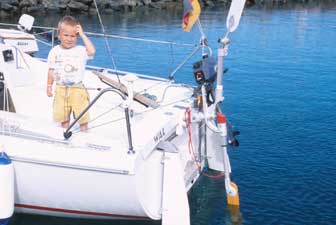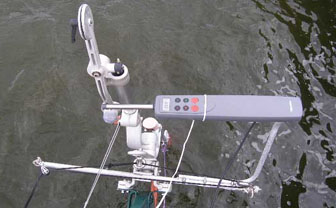 |
|||||
Self-steeringMan or machine - which steers better? We will now consider the advantages and disadvantages of autopilots and windvane systems, look again at how the three common types of vanegear operate and explain why you need the full team of three, windvane system, autopilot and human, for optimal steering on a bluewater yacht. |
|||||
Self-steering under sailMan or machine? A person, especially a sailor, is a fine piece of engineering with the helm in hand: signals flow in from all directions and each is perfectly processed to keep the boat on course. All the senses work together to track apparent wind angle, compass course, sail trim, wave patterns, weather clues, heel, the weight of the helm, navigation advice and other traffic in a way so far unmatched by any machine. Unfortunately this utopian picture fades with time: tiredness soon begins to make its presence felt, especially where combined with inexperience, and steering performance starts to slip as the eyes slowly close... Automatic steering for sailing craft was a logical answer to the question of how to sail further in comfort. Thirty years ago you could say with some confidence that any boat with a windvane steering system was a serious bluewater voyager. Autopilots, in contrast, were originally picked up by the average weekend or holiday sailor looking for a little respite from the helm. The idea of using an autopilot for passage making was at that time almost as absurd as putting a clumsy great big windvane on your boat for a day trip along the coast. Both types of system had their clientele and there was little if any overlap. Fortunately autopilots and windvane systems have both evolved almost beyond recognition since those early days and sailors have become much better informed. The heated arguments for and against that once kept yacht club lights burning on into the night can now thankfully be consigned to history! The improvements made in both systems have resulted among other things in a blurring of the boundaries. There are essentially three ways to steer a boat: by hand, with an autopilot or with a windvane gear. We will now look at the strengths and weaknesses of each option using the human helm as our benchmark (after all he or she is the alternative to whom we can most easily relate). Man, Autopilot, VanegearA sailing boat is from an engineering point of view an inherently unstable system: with constant attention to the rudder it will never maintain a straight course. The force needed to keep the boat on course varies from minimal to very large as a function of the conditions, wind angle and so on. The amount of action required at the helm depends first and foremost on design. Ideally the boat should have a natural tendency to turn slightly to weather so that a few degrees of lee rudder are enough to keep it on course (effective steering is all but out of the question if the boat's natural inclination is to leeward). The strength and skill of the helmsperson aside, there exists a set of boundary conditions beyond which the boat will always overpower the rudder and do its own thing. A strong, fresh and experienced human helm unquestionably remains the most effective steering option across the full range of conditions, but people, unlike machines, suffer from tiredness, boredom and an inexhaustible ability to think about how much more fun they could be having if they were under the spray hood with a good book and a hot drink rather than standing at the wheel eating waves. If you want to sail a long way with a small crew and enjoy the trip, you will have, sooner or later, to hand over to an autopilot or vanegear. AutopilotsAutopilots might not need to sleep, but they certainly need to feed and a hard-working system can drain a ship's batteries pretty fast. Modern autopilots have advanced software controllers that monitor compass course, deviations from course and the general movement of the boat to ensure that steering actions are effected at the right moment, with the necessary force and, most importantly as regards power consumption, as rarely as possible. Based on the consumption figures for individual systems it is possible to deduce that a typical Autohelm unit, by way of example, only actively steers the boat 25 % of the time. This means, in other words, that the rudder is only actually being moved for 15 minutes in every hour of autopilot steering and is simply held still for the remaining 45. Obviously this suffices to keep the boat on course in most cases but does perhaps suggest why it is that autopilots are still unable to match human performance. Autopilots comes in two different varieties: Cockpit autopilots Inboard autopilots, Both types of autopilot are network compatible and can be integratedwith other modules in an electronic navigation system. This means, for example, that the autopilot can be set to steer to a GPS waypoint rather than a compass course. Nicely presented in ampere-hours, the consumption figures for an autopilot can at first seem reassuringly low. Multiply by 24 and count the number of days you intend to be at sea and all of sudden the situation starts to look much less encouraging. All the energy taken from the batteries while at sea has to be replaced while at sea. Autopilots are very good at doing what they do best: steering to a compass course. Steering to the apparent wind, on the other hand, is not one of their strengths. The tiny windvane transducers used with most autopilots are just too easily misled: even the slightest movement of the boat in any direction has an immediate effect on the apparent wind angle and it seems unrealistic to expect the autopilot's software immediately to be able accurately to deduce the real state of affairs from the erratic movements of such a small vane. Heavy weather also poses problems for an autopilot. While a competent human helm automatically reacts faster and applies more force to the steering as wind and seas build, an autopilot can neither steer faster nor push/pull/turn harder. An autopilot with a choice of transmission ratios or different power settings has yet to appear. The compass is always going to be the only reliable source of a steering signal for an autopilot, which is why most of the autopilot manufacturers have invested so much in developing better technologies like the fluxgate compass and, more recently, the more advanced gyrocompass. Nothing matters more when sailing than the position of the boat and sails relative to the apparent wind, which makes this weakness of the autopilot a major drawback - compass courses are all very well, but it really makes no difference which way the boats is headed if the sails are stalled! Cockpit autopilots are small and discrete, easy to install and operate and inexpensive. Inboard pilots may be larger and more expensive, but they are hidden away completely out of sight and are just as easy to use. They may not be as reliable as everyone might like, but that seems to be the way with marine electronics! Depending on what you plan to use your autopilot for, you either live with the possibility of it failing or carry spares or backups. |
Windvane steering systemsThirty years or so of development has produced twelve different approaches to the challenge of windvane steering. Nine of these have now fallen by the wayside leaving the market open to the three remaining alternatives: Auxiliary rudder systems look to the windvane not only for the steering signal but also for the energy to turn the auxiliary rudder itself. Naturally this necessitates a large windvane. The main rudder is adjusted to balance the boat and compensate for any weather helm and then locked in place. Simple auxiliary rudder systems have no servo unit to generate extra power and cannot therefore be relied upon to deliver effective steering for boats much longer than 10-12 m/33-40 ft. Servo-pendulum systems amplify the signal from the windvane by using it to control a small rudder blade (the pendulum rudder) trailing in the water behind the boat. The servo principle is easily illustrated: imagine standing at the back of your boat doing 6 knots trailing a 2 metre long wooden plank in the wake. Aligned exactly parallel to centreline the plank takes little effort to hold, but if you rotate it one way or the other it moves forcefully to the side. Now picture the same effect with the plank replaced by the pendulum rudder and shaft and the signal from the windvane doing the rotating. Servo-pendulum gears are surprisingly powerful and can effectively manage boats of up to 30 tonnes provided the lines linking the pendulum arm to the tiller or wheel transmit the steering force efficiently. Best results are obtained with tiller steering and some wheel systems are wholly incompatible with conventional servo-pendulum designs. Steering performance essentially depends on how efficiently the force applied by the pendulum arm can be transmitted to the main rudder. An inefficient system will lose control long before a better designed equivalent. Double rudder systems also use the signal from the windvane to activate a servo-pendulum assembly, but this time the force generated is passed directly to the unit's own auxiliary rudder rather than to the boat's main steering system. Being completely independent of the main rudder, this type of system is perfect for the large centre cockpit boats now so popular on the bluewater scene. Advantages and disadvantages of the three options Human: Autopilot: Windvane system: Synthesis: Those are the facts. So what are we to conclude? Steering on a day or weekend trip is fun and you and your crew are perfect for the job. If you plan to spend longer at sea, especially short-handed, an autopilot is a worthwhile addition. - the windvane system for sailing, |
||||
 |
|||||
Autopilot versus WindpilotAutopilot advantages Hidden Autopilot disadvantages Compass course not ideal under sail Windvane steering system advantages Steers to the wind Windvane steering system disadvantages No use in a flat calm |
|||||
